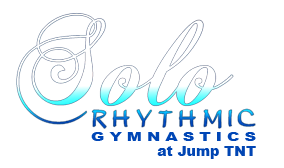Rhythmic Gymnastics is the most fascinating Olympic sport. It blends the dynamics of gymnastics with art of ballet and the self expression of modern dance. A rhythmic gymnast has the suppleness of an acrobat, agility of a juggler, and lightness of a butterfly. While Artistic Gymnastics is centered around acrobatic elements, Rhythmic gymnastics preferences dance-like movements, flexibility, and the coordination of body movements with those of the apparatus. Athletes require a full range of flexibility throughout the entire body in addition to extreme agility. Both factors combined allow athletes to maintain perfect body alignment in leaps, balances, pirouettes and other intricate movements. Athletes display a high level of coordination and unity with their hand-held apparatus. They posses rhythmic sensibility while taking risks with technical precision.
Rhythmic Gymnastics is recognized by the Federation of International Gymnastics. There are two different types of competition in Rhythmic Gymnastics: Individual and Group. In the Group Competition 5 athletes work together as one. They use one of the hand-held apparatus or a combination of two different pieces (i.e. Ribbons and Hoops). To watch the combination of 5 different personalities meld together to perform intricate compositions involving high-flying throws and exchanges is truly thrilling. The element of cooperation among the athletes is essential resulting in a breathtaking, harmonious unit.
The best way to learn about Rhythmic Gymnastics is to see it. Go to YouTube.com and type in “Anna Bessonova” , “Inna Zhukova” or “Yevgeniya Kanayeva” to watch the routines of the medalists of Olympic Games
Rhythmics is NOT easy! video:
Physical/Coordination Skills
- Develops strength and agility on both sides of the body.
- Enhances fine motor skill coordination and manual dexterity development by using hand-held apparatus.
- Develops gross motor skills by incorporating large body movements such as running, skipping, galloping, jumping, hopping, balancing, turning, and leaping.
- Develops strength through gross motor skills.
- Develops hand-eye and foot-eye coordination.
- Improves flexibility through safely stretching muscle groups prior to static and dynamic activities.
- Develops a keen sense of balance.
- Develops grace using various dance movements with music
Psychological and Social Skills
- Helps develop self confidence, and self discipline
- Sharpens focus and concentration
- Enhances self expression and creativity.
- Helps gain valuable team-working skills.
- Promotes a healthy and active lifestyle.
- Exercises the ability to set and achieve goals.
Lifelong Skills
- Develops an early sense of rhythm as it introduces different styles and tempos of music.
- Develops musicality and enhances auditory awareness.
- Develops spatial awareness through movement in a large space.
- Introduces the concept of levels and speeds.
- Develops memory retention by teaching various combinations of skills.
- Develops directional skills and use of patterns through a variety of techniques with equipment.

